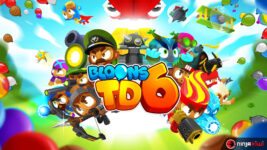
Gamer Recognizes Game: ‘Bloons Tower Defense 6’
If you’re looking for an amazing game or you really hate latex, BTD6 is the game for you. Photo courtesy of Ninjakiwi.
I have fond memories of Flash games. I spent countless hours on Kongregate and Cool Math Games playing all sorts of different games to pass the time in school or at home. But after a while, I started to grow out of playing most of them. Here and there I would spend a bit of time playing them to recapture a bit of nostalgia, but I didn’t play most of them frequently until Adobe announced it was shutting down Flash.
One series that has its beginnings deeply rooted in the history of Flash games has always stuck with me, and with the current game being the last in the series, I wanted to put it in the spotlight: “Bloons Tower Defense 6” — “BTD6.”
The premise is simple: You must keep the balloons — referred to as bloons — from reaching the end of the track with the resources available to you. This is the same format that normal tower-defense games adhere to.
Bloons are an evil species that resemble balloons who seek to destroy the monkeys’ village. It is up to the player to keep that from happening by placing monkey defenses around the track to destroy the oncoming waves of bloons.
Each monkey has different ways of popping balloons, from boomerangs and guns to magic and tacks. There are 24 unique monkeys in total, with each monkey having three upgrade paths that can be invested in — changing how they interact with bloons and how many they can pop.
Beyond the standard 24 monkeys, you can select one hero monkey that only costs in-game currency to be placed on the map, and upgrades itself over the course of defending the monkey village.
There are also different kinds of bloons, with some being camouflaged, some made of materials other than rubber and some being blimps. These all require different methods to pop, hence the reason for each monkey having different upgrade paths to change how they operate.
While the game is simple in concept and highly repetitive, it’s easy to get sucked into the complexity of different map setups, combinations of monkeys, and earning medals on every map.
Each map has three standard difficulties — easy, medium and hard — and within those difficulties are different bonus challenges for that specific playthrough of the map. If you complete a map and those challenges, you earn a medal. With 82 maps in the game, and each map having 14 medals, there is a grand total of 1,148 medals to be earned between all the maps.
A new addition to “BTD6” is a progression tree, with monkey knowledge being earned at different milestones that you can use to upgrade the paths of the four types of monkeys — primary, military, magic and support.
What keeps me playing is how many devices I can play it on. It is playable on some consoles, PC and even mobile devices, with the price ranging from $7 on mobile to $30 on console. I love playing it on my setup at home while also having the ability to keep playing it during a multi-hour flight or drive on my phone or tablet.
While some games with this range of platform accessibility would make you have different save files on every platform you play on, “BTD6” allows you to transfer saves across all platforms you play on.
It’s a game you can easily pick up for a quick run of a map, or you can spend hours theory crafting combinations of monkeys and trying to get to the highest round possible before the bloons inevitably overwhelm your defenses.
Despite releasing in 2018, “BTD6” — along with previous series entry, “BTD5” — still receives regular updates from Ninjakiwi. Their goal is to make “BTD6” the definitive game of the series, which they have so far succeeded at through various game ideas along with consistent updates.
With as many hours as I’ve put in, there are still so many parts of the game that I haven’t gotten into playing, such as Odyssey, various boss events and Contested Territory. These are all different takes on the standard formula of the game that help make playing the same maps with the same monkeys feel less repetitive by adding a competitive element in addition to occasionally restricting what monkeys you can and cannot use.
My one complaint with “BTD6” is how long it can take to fully unlock all of the monkeys. You progressively unlock monkeys as you play, and unlock upgrades on each monkey’s upgrade path as you use that monkey in-game. This can get tedious fast, as unlocking five tiers of three upgrade paths for 24 monkeys — along with some monkeys having a sixth “paragon” tier — takes forever.
However, there are ways to optimize this process, and once you unlock the paths for most monkeys, you only have to grind out unlocks when Ninjakiwi adds a new monkey.
Overall, “BTD6” is solid and an amazing time killer. It is highly replayable, but also allows for a large amount of depth in how you can combine monkeys to attack on different maps. The constraints of map challenges — as well as different achievements for beating maps in specific ways — make you think outside the box and keep the game from getting too old too fast.
While many fans of the game still hold out for a seventh entry in the series, I wouldn’t be too upset if “BTD6” was the last game. It feels definitive, and a lot of love has been poured into continuing to make this game the best of the series. Whether you’re a big fan of monkeys or just looking for an incredibly solid tower defense game, this is a game you might want to check out.



